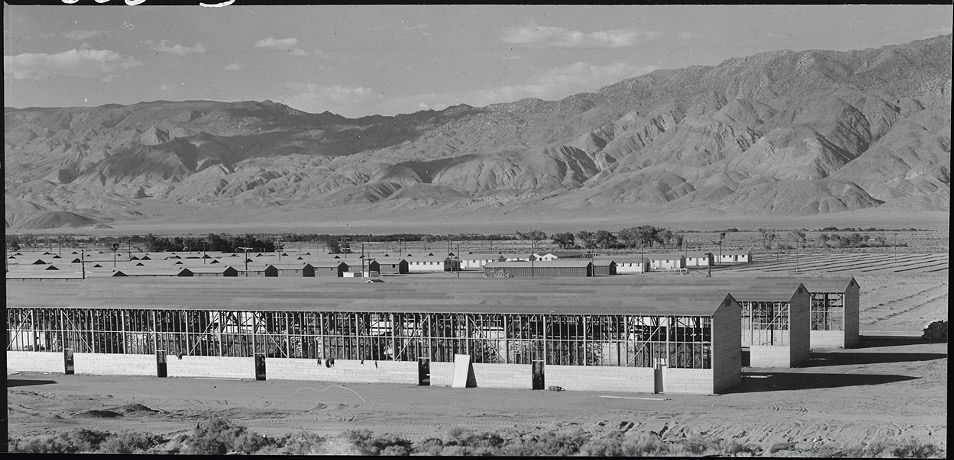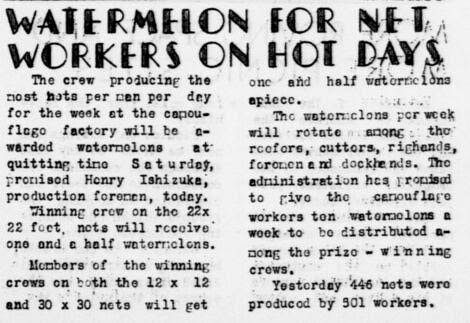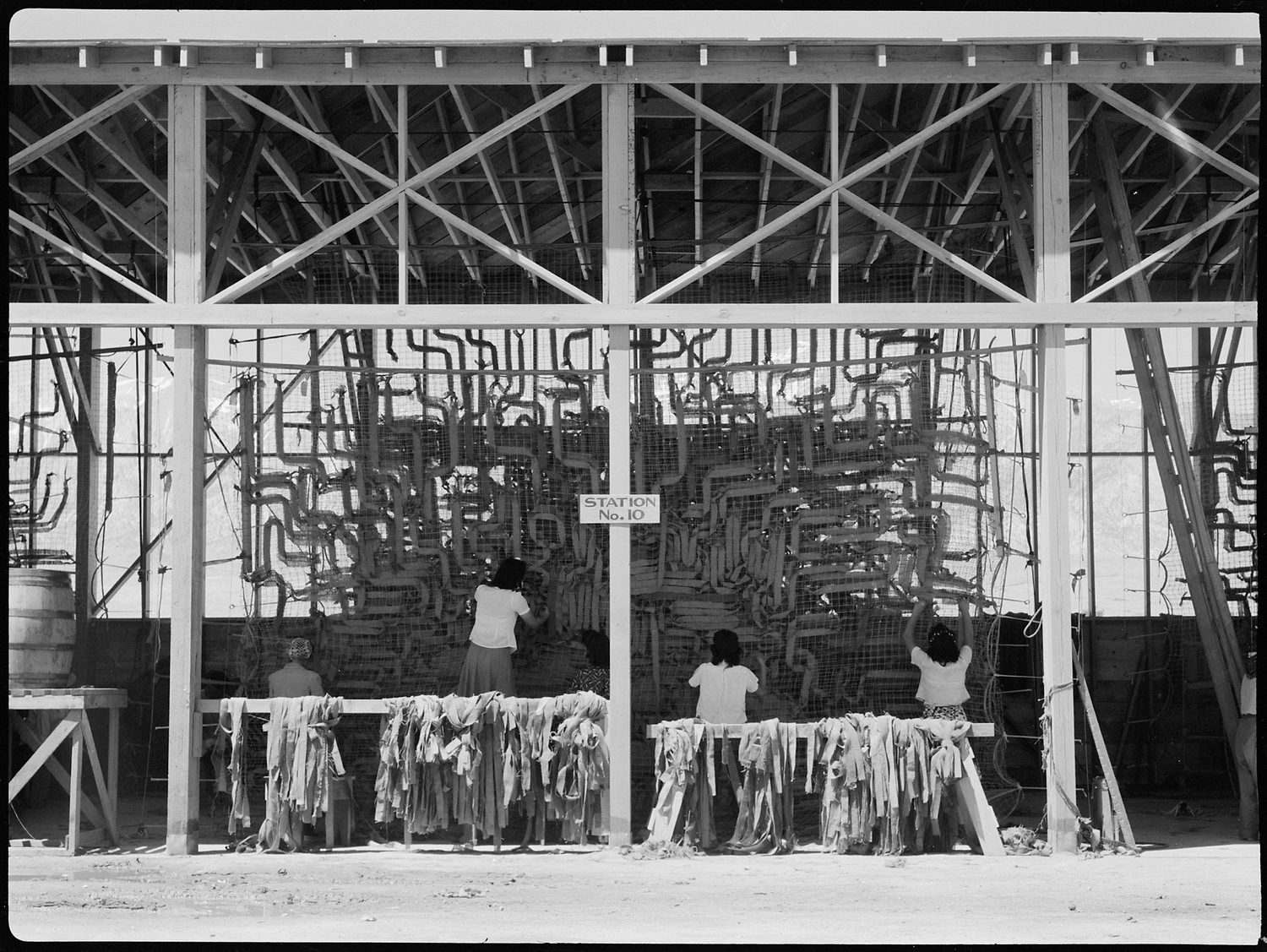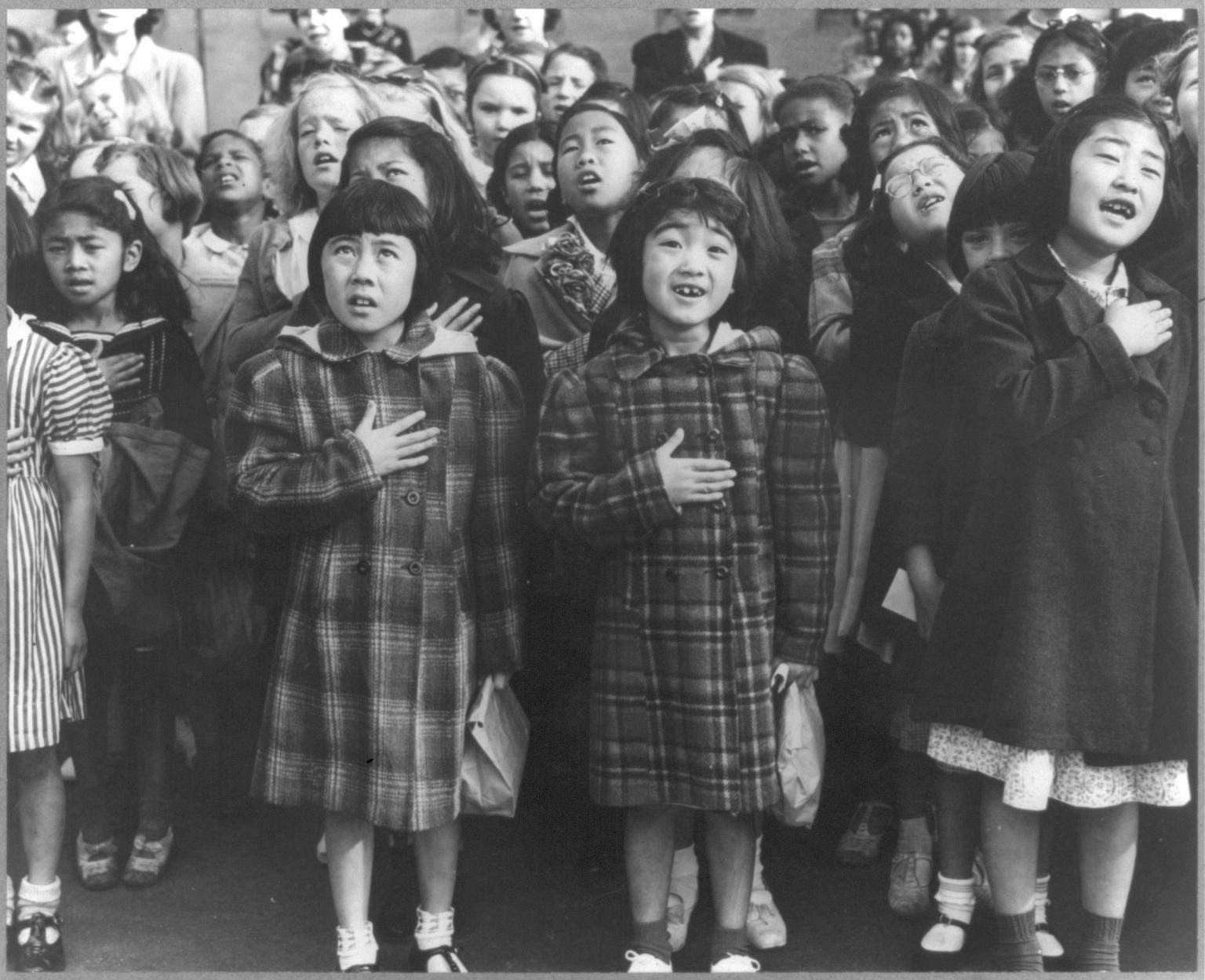How can one reconcile the hard line inherent in any politics and the questioning essential to any relation? Only by understanding that it is impossible to reduce anyone, no matter who, to a truth he would not have generated on his own.
—Édouard Glissant, “On Opacity”
There were four classifications for prisoners of the Japanese internment camps: Issei referred to first generation immigrants from Japan; their children, born as American citizens, were called Nisei/Nikkei (first generation according to American standards); Kibei classified Japanese-American citizens who were educated in Japan; Sansei referred to third generation, who would have been children at camps. Rights of the incarcerated were established based on these categories and further delineated by their access to jobs and various privileges, which developed people’s attitudes and politics accordingly.
Employing only Nisei for the war efforts – camouflage net production, Guyana rubber plant farming – allowed a loophole for the government to institute what was in fact forced labor, under the Geneva Conventions.1See "Article 50" in the link. Work was ostensibly paid, however minimally, and camouflage net workers were the first to be paid. This incentive increased production for the WRA without ostensibly breaking international law. In her analysis of Dorothea Lange’s photographs of the camouflage net workers, scholar Linda Gordon points out,
These undertakings were illegal under the Geneva Convention, which forbade using prisoners of war in forced labor, and as a result only American citizens were usually employed so that the army could claim these were not POWs [Prisoners of War].2Gordon, Linda. Et al. Impounded: Dorothea Lange and the Censored Images of Japanese American Internment (New York: W.W. Norton + Co., 2008). 34.
Hired by WRA, to document this labor, Lange had, as described by Alinder in Moving Images, “an almost impossible representational task – portraying Japanese Americans as loyal citizens while at the same time condoning their imprisonment.”3Alinder, Moving Images, 23. However, despite the contradictory nature of Lange’s documentation, “establishing a practice of documentary photography gave the WRA an appearance of transparency.” 4Ibid., 41. Yet, as is demonstrated by the impoundment of her photos by the U.S. government, Lange captured something other than what the WRA wanted to see. I sense a protectiveness from Lange of her subjects in her photos. And I believe she accomplishes this air of empathy through a lens of opacity – not assuming onto her subjects either victimization or loyalty. But rather, making visible some hints of what her subjects were experiencing – laying groundwork for future scholars and historians to unearth buried histories of incarceration and exploitation by the U.S. of its own citizens.
The high production of camouflage nets, on the one hand, reflect the internees’ dexterity in weaving and craft, as well as self-motivation, of which the authorities took note and recognized as a valuable opportunity to exploit their personal talents for the sake of war. Concurrently, The Manzanar Free Press – a newspaper edited by prisoners but highly censored by the U.S. military – was used as a propagandistic platform to incentivize war labor efforts. Announcements of payment were published in The Manzanar Free Press, along with numbers of workers, levels of productivity, and quotas. Competition was encouraged through this reportage, along with notes of congratulations, approval of loyalty, and even incentivized watermelon rewards for crews producing most nets per day.5The Manzanar Free Press(Manzanar, CA.: Manzanar Relocation Center, to 1945). See the link.
In reviewing archives of The Manzanar Free Press, I compiled a shared file for the published articles and was able to interrogate these colonialist modes of exploitation and manipulation of incarcerated persons as laborers. Tracking headlines related to the camouflage net project highlighted the “dialectical significance” of what the anti-colonialist theorist Frantz Fanon termed “a perverted logic” and the “effort to demean history prior to colonization today.” Fanon writes in The Wretched of the Earth,
Colonialism is not satisfied with snaring the people in its net or of draining the colonized brain of any form of substance. With a kind of perverted logic, it turns its attention to the past of the colonized people and distorts it, disfigures it, and destroys it. This effort to demean history prior to colonization today takes on a dialectical significance.6Fanon, Franz; Farrington, Constance (Trans.). The Wretched of the Earth (New York: Grove Press, 1961). 149.
With all odds against them, the internees created structures for education and social activities at Manzanar, including a library, organized sports, a local newspaper, religious ceremonies, theatrical performances, and even low-level local government structures. However, no books in Japanese were allowed in the library and the newspaper was heavily censored, while sports were limited by extreme weather conditions and equipment access. 7See “Article 38” of the Geneva Convention. Efforts to organize, strike, or resist were quickly suppressed by the military through isolation punishment, relocation, revocation of privileges, and even the shooting of prisoners by guards.8See Ibid., “Article 78”. Japanese-Americans were nonetheless expected to perform their national loyalty to the U.S. throughout their incarceration, for not only army personnel, but the American public through their representation in the press. In critique of a nation’s attempt at “cultural innovations” to reassert the value of Indigenous culture within the context of colonial domination, Fanon writes,
Hence we arrive at a seemingly paradoxical proposition: in a colonized country, nationalism in its most basic, most rudimentary, and undifferentiated form is the most forceful and effective way of defending national culture.9Fanon, The Wretched of the Earth, 177.
If we apply this “paradoxical proposition” of Indigenous populations to the predicament of Japanese-Americans between 1942 and 1946, the reality of what Fanon calls “national culture” is difficult to delineate. Yet his analysis lends an apparatus for us to describe the kind of manipulation the U.S. government used against its citizens. In 2020, some mainstream media acknowledges the extent to which the U.S. economy is dependent on the exploitation and incarceration of Black and Indigenous populations, but it is important to recognize that using such mechanisms of control on people of Japanese origin was fairly new in the 1940s. This reapplication demonstrates how quick the U.S. is to use dehumanizing strategies on whatever population gets in the way of white progress and accumulation of capital. Were it not for the resilience of the internees building their own cultural infrastructure, the media would have had a much harder time suppressing the vulgar and inhumane conditions that tens of thousands of people were suffering – more than half of whom considered the U.S. as their country of origin.
Fanon goes on to describe “national culture” as the “tensions internal and external to society as a whole and its multiple layers,” and presents us with a difficult task of entanglement. As we fold back these layers of territorial thresholds, the lines of outside and inside come to determine who receives which civil rights and where. In the case of the Japanese internment camps, yet another population of people of color was forced into production of a culture which systematically occludes and subsumes the diversity in heritage of its constituents.
We shall return our attention to the Geneva Conventions, which the WRA evaded through hiring only Nisei for war production efforts. First put forth in 1864 by the Red Cross to ensure medical care for the wounded, amended in 1949 after WWⅠⅠ, and further elaborated in 1977, the Conventions were established as a standard of international law for humanitarian treatment of civilians, POWs, and soldiers during armed conflict – and have since been ratified by 196 countries.
Article 13 in the Conventions reads: “Prisoners of war must at all times be humanely treated. Any unlawful act or omission by the Detaining Power causing death or seriously endangering the health of a prisoner of war in its custody is prohibited, and will be regarded as a serious breach of the present Convention.” It is clear when we look at which protections and civil liberties were or were not granted to prisoners of the Japanese internment camps that, in regards to the Conventions, the U.S. breached multiple articles.
In 2015, the U.S. was once again accused of violating the terms of the Conventions at Guantánamo Bay detention camp, for various offenses including the refusal to release Tariq Ba Odah, a Yemeni Guantánamo detainee suffering from severe malnutrition and deterioration following an eight-year hunger strike.10See “Article 110” of the Geneva Convention, and the link. In her 2005 book Abolition Democracy, Angela Davis writes:
I think that you are right that there is a widespread assumption that torture could never occur in U.S. borders. As a matter of fact, in the earliest conversations about the violations of prisoner’s human rights at the military prison in Guantánamo, government officials distinguished between what was allowable offshore and what was allowable within the territory of the United States.11Davis, Angela. Abolition Democracy (New York: Seven Stories Press, 2005). 71.
This question of how to define what constitutes torture continues, while the number of the immigrants incarcerated in the U.S. rises. In 2018, 396,448 people were booked into Immigrations and Customs Enforcement (ICE) custody, 242,778 of whom were detained by the Customs and Border Protections and 153,670 by ICE’s own enforcement operations.12U.S. Immigration and Customs Enforcement, Fiscal Year 2018 ICE Enforcement and Removal Operations Report. There are at least 15 active detention centers across the U.S., many without basic facilities or supplies such as blankets and food. To quote a Foreign Policy article from 2019: “In immigrant detention centers, migrants can face a number of conditions that, had POWs been subject to them, would have been clear violations of the Geneva Conventions.”13Sukin, Lauren. “The United States Treats Migrants Worse Than Prisoners of War,” in Foreign Policy, July 26, 2019, accessed from the link. With ICE reports being actively destroyed, the tenuous documentation of this crime against humanity calls into question how images and texts will be written into or erased from a long history of racial prejudice, neocolonialist tactics of incarceration, exploitation, dispossession, and violent exclusion by the U.S. government.
In response to police deploying tear gas on peaceful demonstrators in recent protests, U.S. Representative Alexandria Ocasio-Cortez tweeted a couple of days ago, “Tear gas is a chemical weapon banned in war. It is a deep shame that U.S. leaders chose to tear gas our own people last week. It should never, ever happen again.” The 1925 Chemical Weapons Convention categorized tear gas as a chemical warfare agent and banned its use within the Geneva Protocol. Yet somehow an article of exception permits U.S. law enforcement to utilize tear gas as a mode of riot control against its own citizens.14See the link. Currently, a group of congressional lawmakers are working to ban the use of tear gas by the police.
In reviewing this current conflict, I was reminded of what was referred to as Manzanar Riot, which occurred on December 5-6, 1942. Some three thousand protestors gathered in objection to the arrest of Harry Ueno, a fellow internee and leader of the Kitchen Workers Union, as well as the beating of Fred Tayama, an officer of the Japanese American Citizens League (JACL). The military guards tried to disperse the demonstration by first spraying tear gas, then firing bullets into the crowd, killing two and injuring nine others. In the case of the Manzanar Riot, tear gas was deployed on both citizens and noncitizens alike, thus in clear violation of the Geneva Conventions.
I would like to end with honoring George Floyd, Tony McDade, Rhia Milton, Rem’mie Fells, Ahmed Aubrey, Breonna Taylor, Eric Garner, Michael Brown, Tamir Rice, Rayshard Brooks, Oluwatoyin “Toyin” Salau, just to name a few of the many Black lives we have lost to hate crimes and at the hands of police. I can only hope that this recognition of loss will continue to make this shift in national consciousness toward anti-racism and abolition in our society. I leave you with Angela Davis, discussing the tenets of prison abolition, in a recent interview with Amy Goodman on Democracy Now!,
It’s about learning that safety, safeguarded by violence, is not really safety. . . It’s about the intersectionality of issues. . . What we are calling for is a process of decriminalization; of recognizing that threats to safety, threats to security, come not primarily from what is defined as crime, but rather from the failure of institutions in our country to address issues of health, issues of violence, of education etc. . . So, Abolition is really about rethinking the kind of future we want, the social future, the economic future, the political future.15See the link.
This is the second and last part of the essay.
Chip Chapin engages dance and writing to elaborate possibilities around collective labor, redistribution of resources, and mutual care. Chapin received an MFA from Hunter College, BA from Bard College, attended MSA^ [Mountain School of Art], and LANDING 2.0; is a recipient of The Kossak Painting Grant, Agnes Gund Curatorial Fellowship, and Beth M. Uffner Scholarship; has published in Weekend, Another Tab of Chrome, No Dancing, and Ginger Magazine; performed and exhibited in New York, Los Angeles, Portland, Berlin, Oslo, and Basel. Chapin currently lives and works in Enfield, NY, where they co-founded Complimenta Inc., now under the open acronym c.h.a.m.p.s. (come here and move people slowly).



